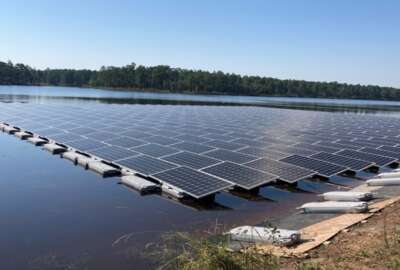DoD’s largest solar array opens at Fort Bragg
The latest attempt to mitigate climate change comes amid National Ocean Month.
The Army is introducing a new way to battle climate change in the military: the largest floating solar arrays in the Southeast United States.
Rachel Jacobson, assistant secretary of the Army for Installations, Energy and Environment will open the Defense Department’s first of its kind array at Fort Bragg on June 10.
The array is a carbon-free power generation method to provide backup power to Camp Mackall during electricity outages and provide supplemental energy to the local grid.
The 1.1-megawatt array, which includes a two megawatt-hour battery energy storage system, is floating on Big Muddy Lake at Camp Mackall.
The Solar Energy Industries Association estimates that in North Carolina, where Fort Bragg is located, one megawatt-hour of solar photovoltaic powers 120 homes.
“This project fulfills the commitment made in our Army Climate Strategy to increase resilience while delivering clean energy and reducing greenhouse gas emissions,” said Jacobson in a release.
The Biden administration has been vocal about minimizing the effects of climate change. On May 31, he declared June to be National Ocean Month and has since released America’s first ocean climate action plan among other suggestions to decrease plastics pollution.
As a part of the action plan, Interior Secretary Deb Haaland will issue an order to reduce and phase out the use and distribution of single-use plastic and packaging products in national parks, wildlife refuges and public lands by 2032.
The order will minimize waste, encourage the recycled products market and attempt to reduce the more than 14 million tons of plastic ending up in the oceans yearly.
Biden also suggested specific steps to create a new national marine sanctuary in the Hudson Canyon of the Atlantic Ocean to provide a habitat for endangered and protected species like sperm whales and sea turtles.
In conjunction with Biden’s efforts, and Fort Bragg’s new array, the Pentagon is focusing on ways to mitigate climate change by limiting its reliance on fossil fuels. Electric vehicles are one option, according to Chief Sustainability Officer Joe Bryan.
“We’ll have a strategy for meeting the president’s objectives to get us to a better place over the next several years,” Bryan said in an interview with Federal News Network. “Outside the Postal Service, the Department of Defense has the largest fleet of vehicles in the government. We’re thinking a lot about how we transition that fleet to electric. That’s going to have benefits for the United States as electric vehicles increasingly become the dominant technology.”
The Army’s latest efforts are part of the Biden administration’s goals to combat climate change. In addition to the solar array, Fort Bragg is getting an electronic recloser, to better protect power lines and minimize damage to equipment during power outages. Among others, reclosers are used to reset and restore power when trees disrupt power lines.
Fort Bragg collaborated with Duke Energy and Amersco to build the solar array and received funding from the Environmental Security Technology Certification Program to get the recloser.
The 2022 Army Climate Strategy lays out specific goals to reduce climate change and the risks associated with it that the Army will face, including increased water scarcity, land degradation and increased demand for humanitarian aid and disaster response.
The goals include a 50% reduction in the Army’s net greenhouse gas pollutants by 2030, compared to 2005 levels; attain net-zero greenhouse gas emissions by 2050 and proactively consider the security implications of climate change on strategy, planning, acquisition and supply chain.
The DoD is specifically interested in mitigating climate change and strengthening its military installations resiliency to the changing weather after a hurricane completely destroyed Air Force Base Tyndall in Florida in 2018.
The use of solar energy is growing across the military. Army Fort Hunter Liggett in California boasts a solar array and is one of the six pilot installations selected by the Army to be net zero energy. In December 2020, Edwards Air Force Base announced a project to develop one of the largest solar arrays was moving forward.
The Bureau of Land Management currently has 870,000 acres prioritized for solar energy development within its land use plans.
Copyright © 2025 Federal News Network. All rights reserved. This website is not intended for users located within the European Economic Area.
Abigail Russ is an intern with Federal News Network.






